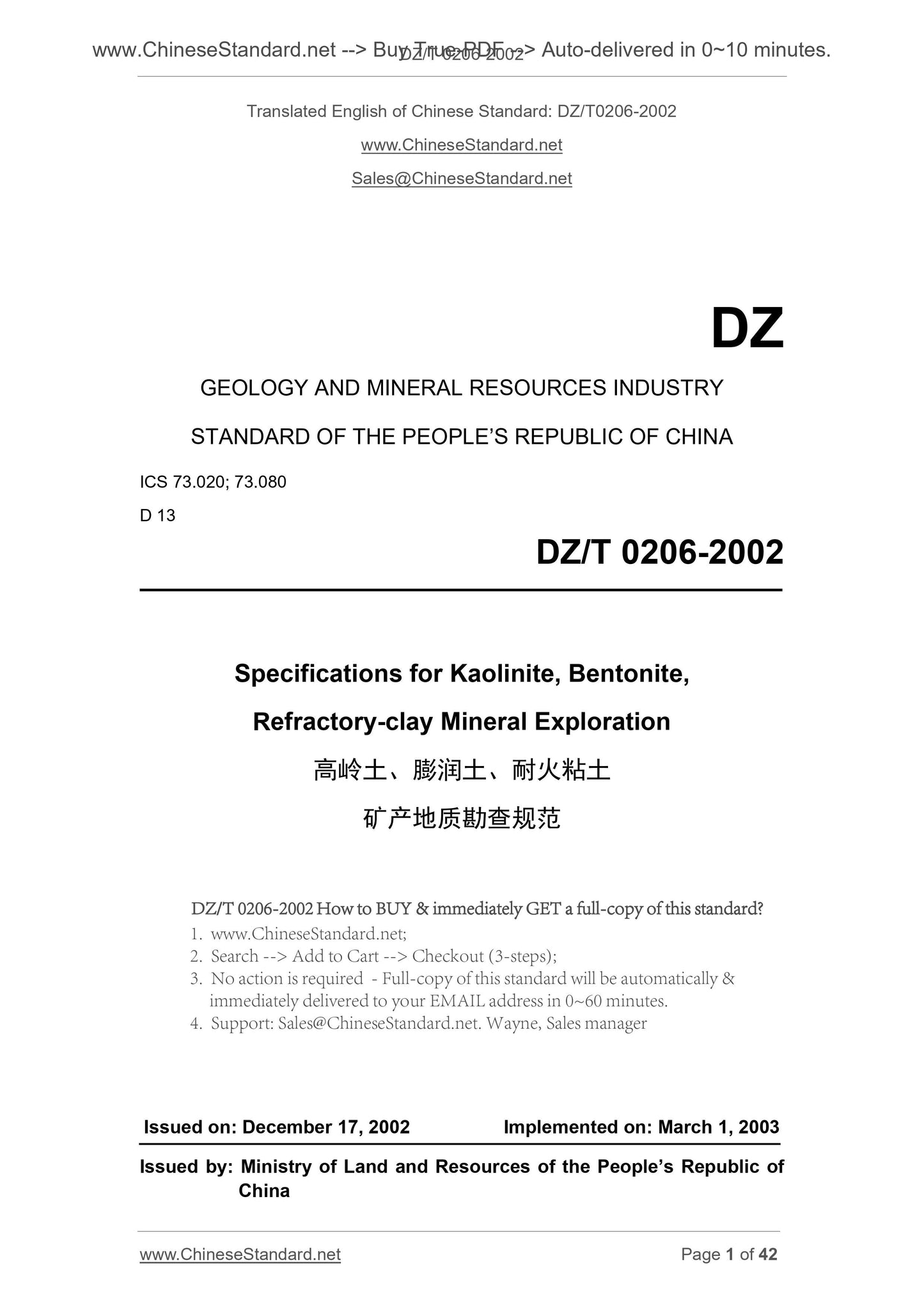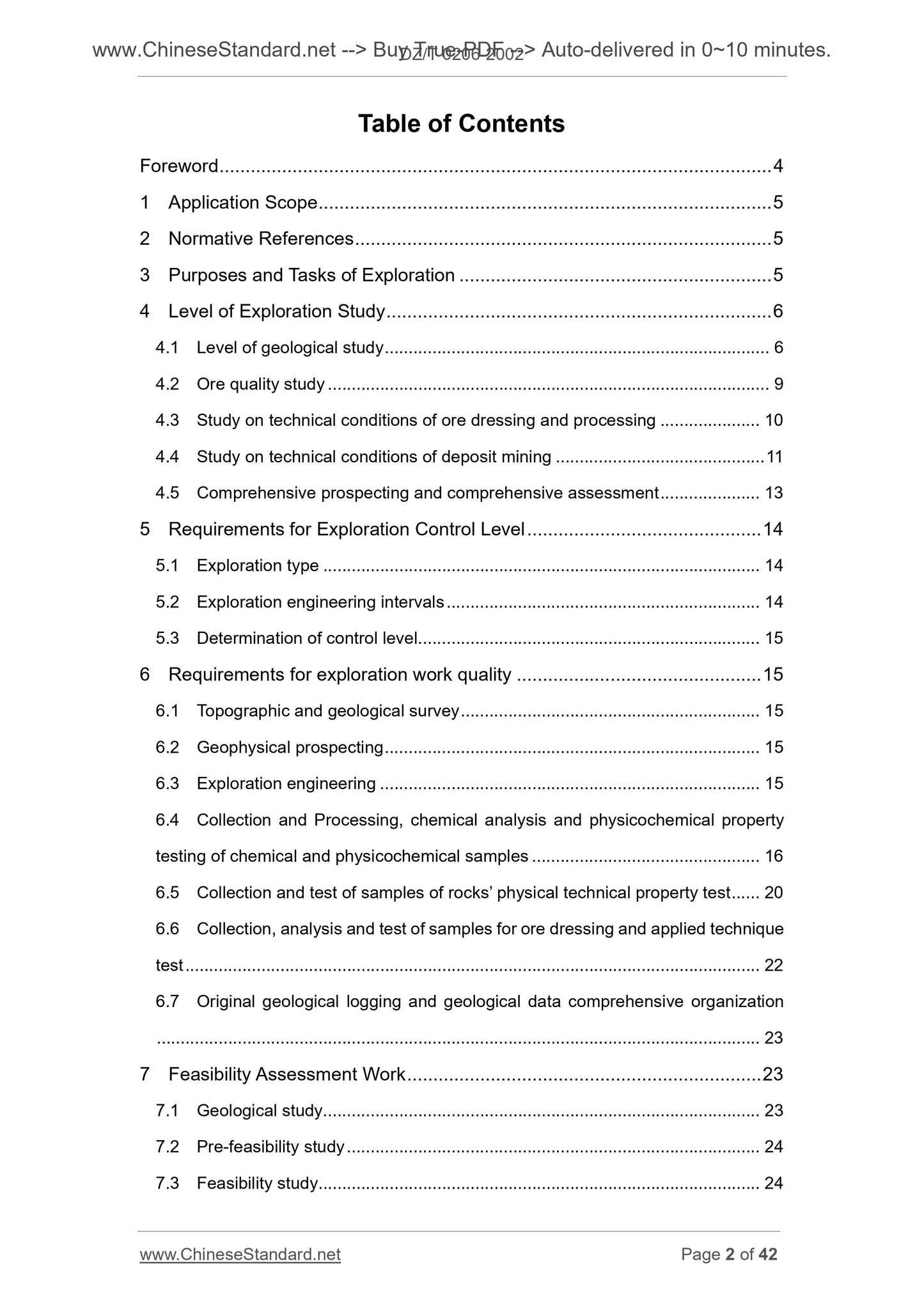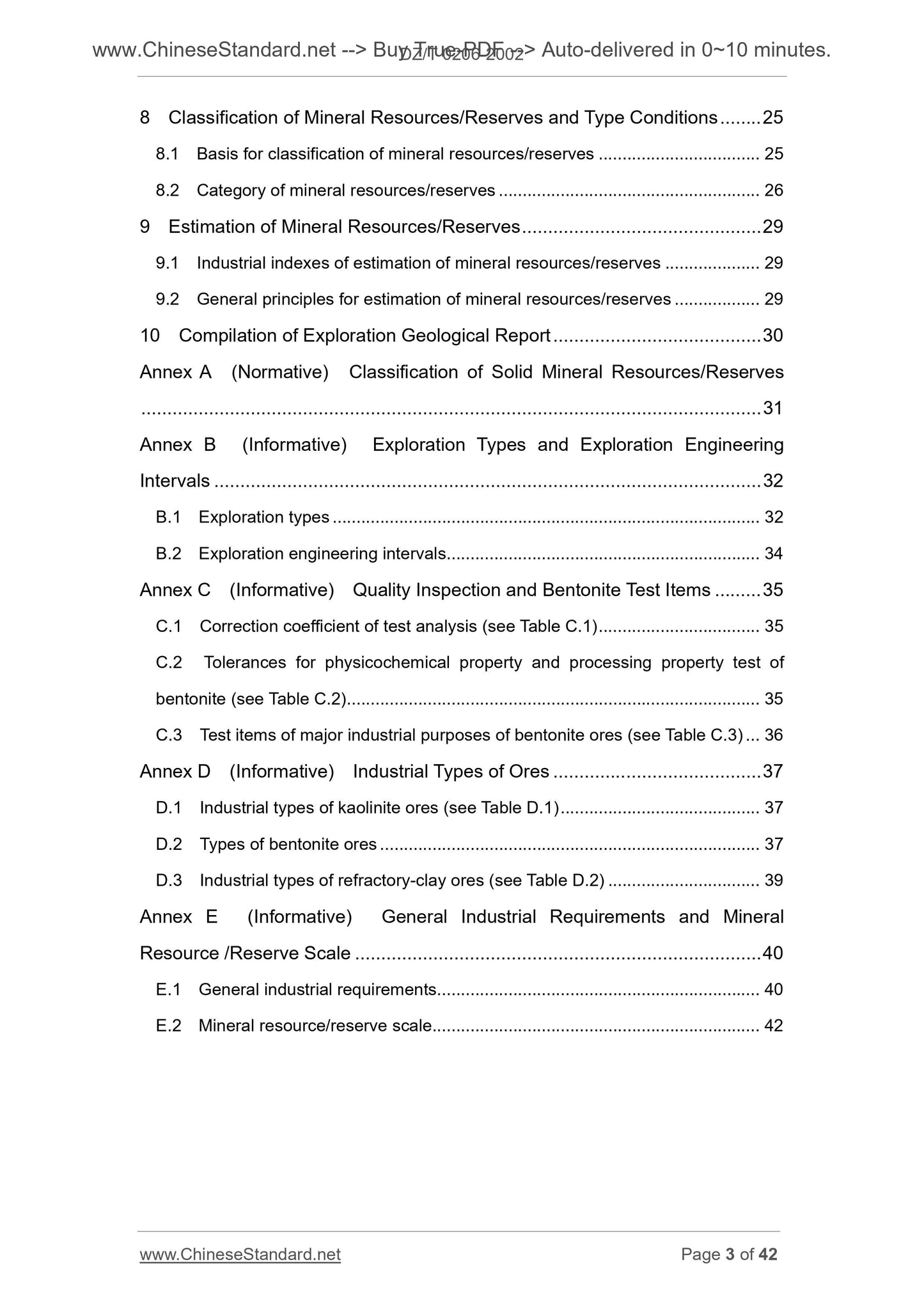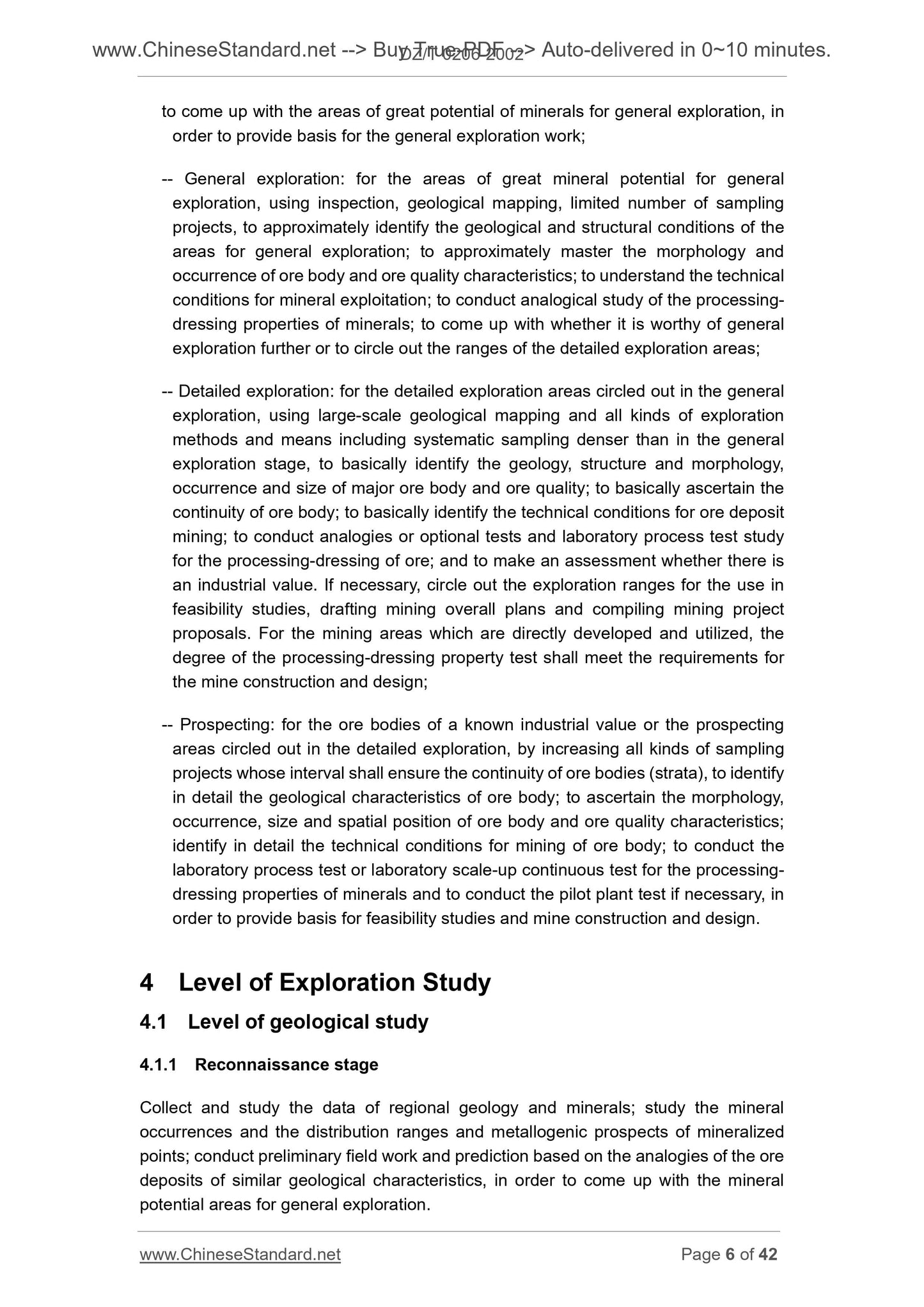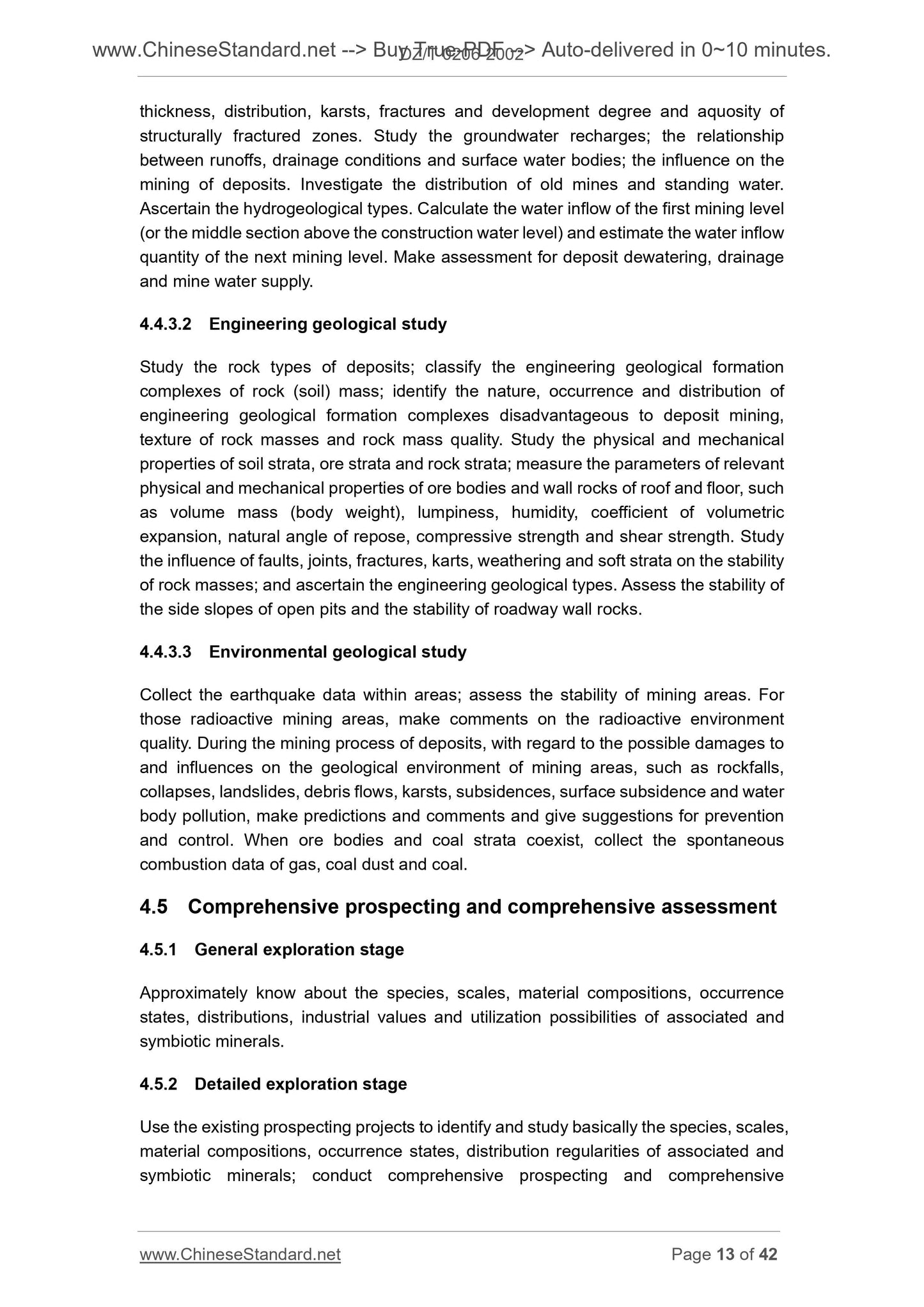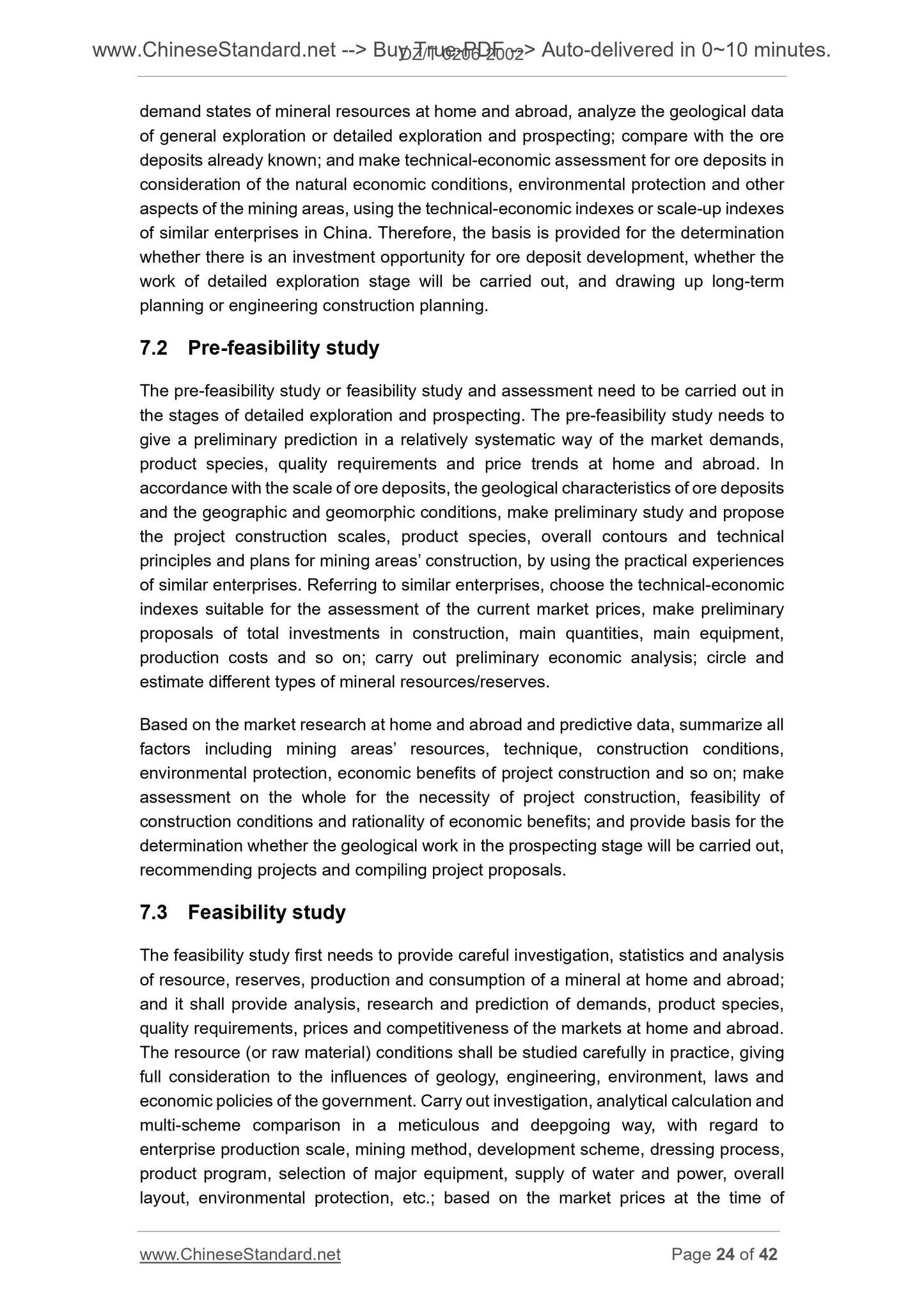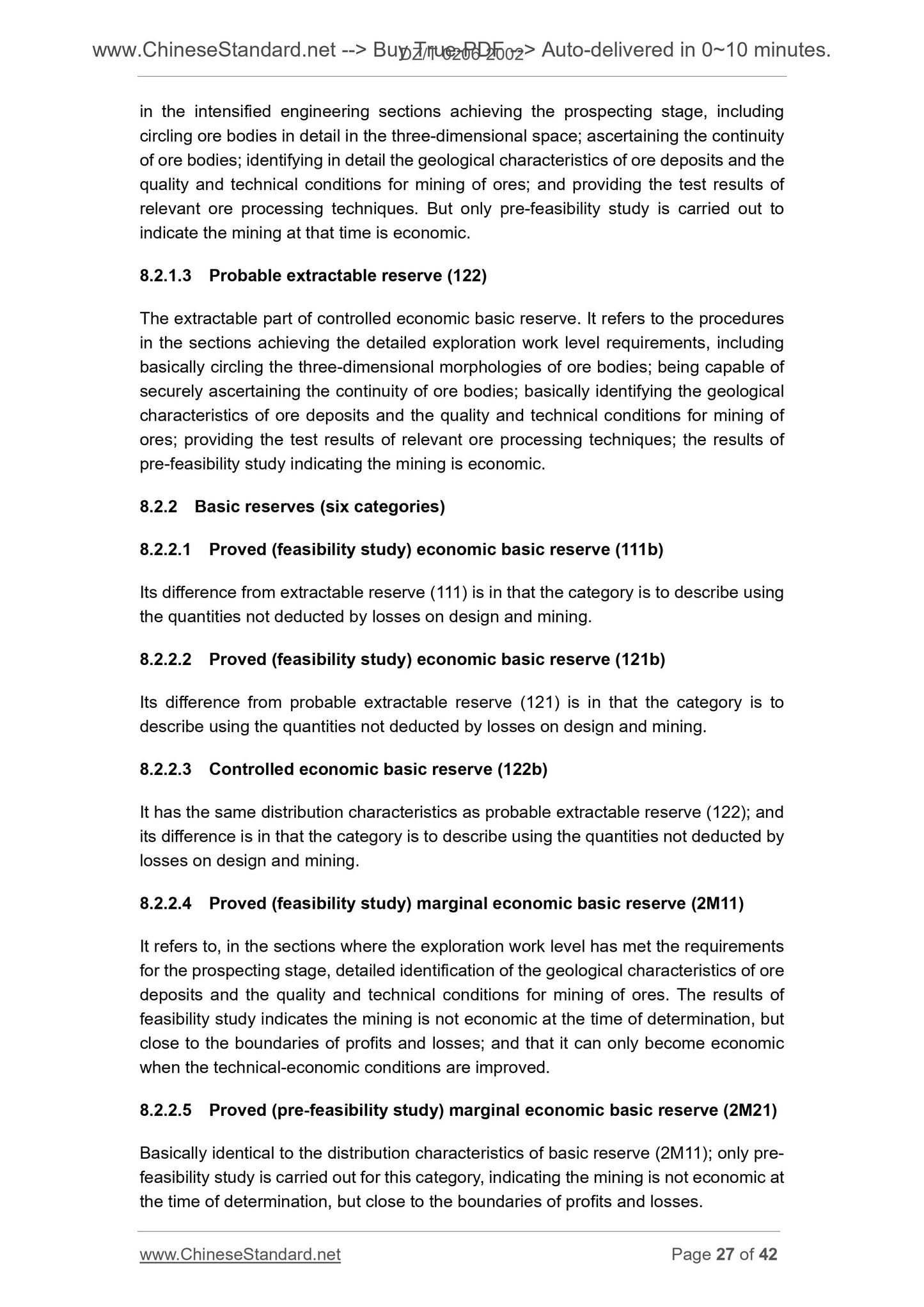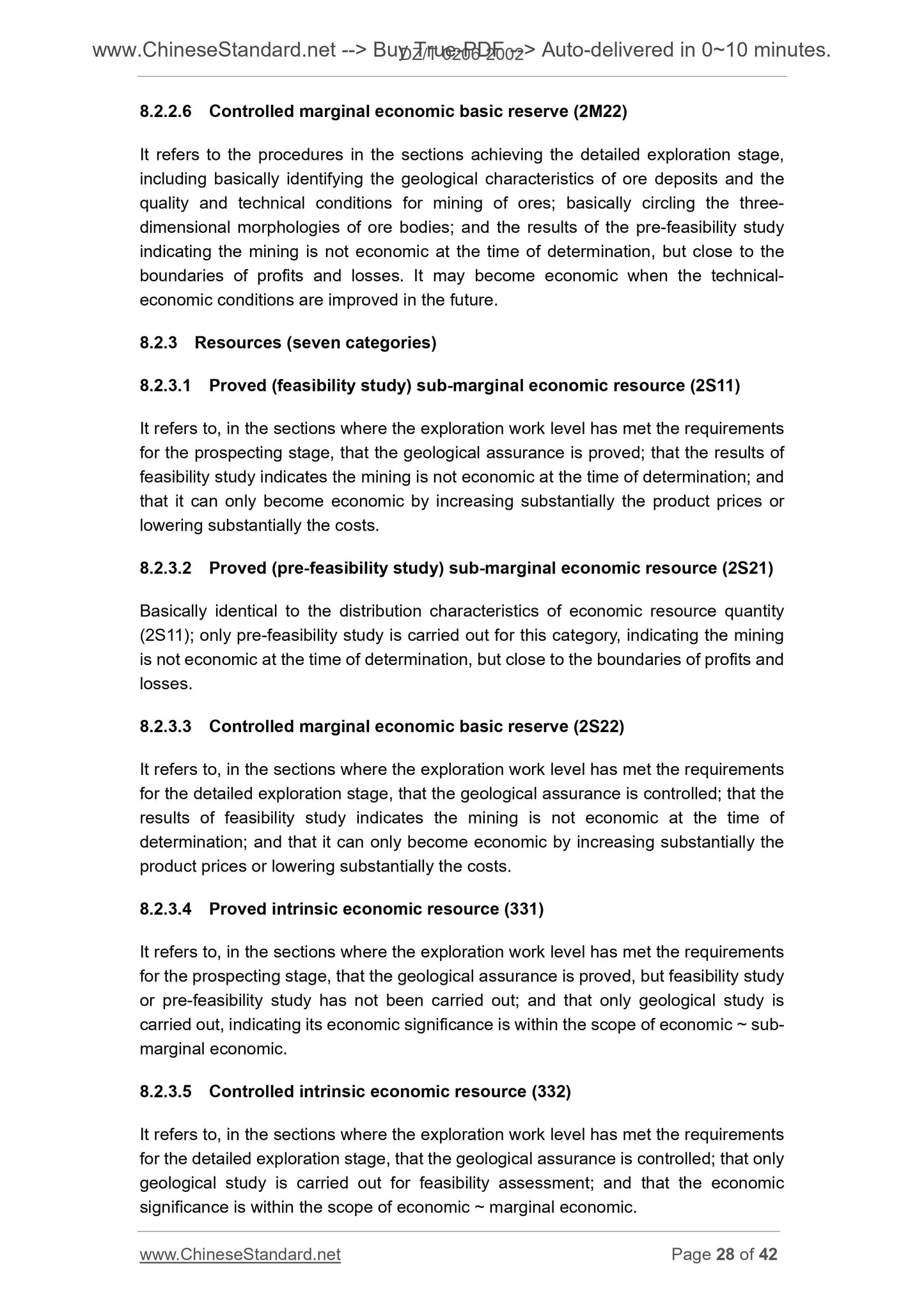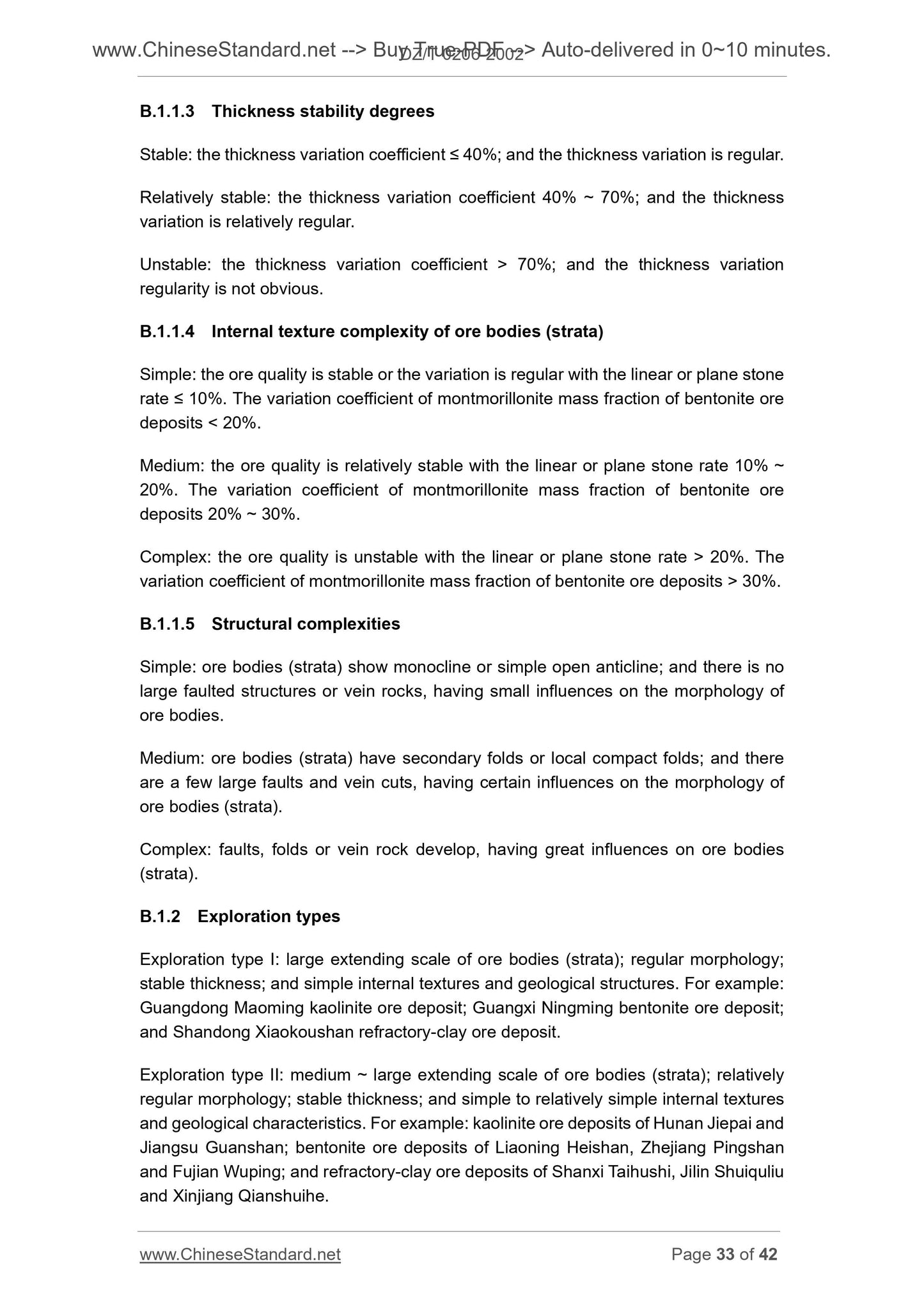1
/
의
11
PayPal, credit cards. Download editable-PDF and invoice in 1 second!
DZ/T 0206-2002 English PDF (DZT0206-2002)
DZ/T 0206-2002 English PDF (DZT0206-2002)
정가
$160.00 USD
정가
할인가
$160.00 USD
단가
/
단위
배송료는 결제 시 계산됩니다.
픽업 사용 가능 여부를 로드할 수 없습니다.
Delivery: 3 seconds. Download true-PDF + Invoice.
Get QUOTATION in 1-minute: Click DZ/T 0206-2002
Historical versions: DZ/T 0206-2002
Preview True-PDF (Reload/Scroll if blank)
DZ/T 0206-2002: Specifications for kaolinite, bentonite, refractory. Clay mineral exploration
DZ/T 0206-2002
DZ
GEOLOGY AND MINERAL RESOURCES INDUSTRY
STANDARD OF THE PEOPLE’S REPUBLIC OF CHINA
ICS 73.020; 73.080
D 13
Specifications for Kaolinite, Bentonite,
Refractory-clay Mineral Exploration
高岭土, 膨润土, 耐火粘土
ISSUED ON. DECEMBER 17, 2002
IMPLEMENTED ON. MARCH 1, 2003
Issued by. Ministry of Land and Resources of the People’s Republic of
China
3. No action is required - Full-copy of this standard will be automatically and
immediately delivered to your EMAIL address in 0~60 minutes.
Table of Contents
Foreword ... 4
1 Application Scope ... 5
2 Normative References ... 5
3 Purposes and Tasks of Exploration ... 5
4 Level of Exploration Study ... 6
4.1 Level of geological study ... 6
4.2 Ore quality study ... 9
4.3 Study on technical conditions of ore dressing and processing ... 10
4.4 Study on technical conditions of deposit mining ... 11
4.5 Comprehensive prospecting and comprehensive assessment ... 13
5 Requirements for Exploration Control Level ... 14
5.1 Exploration type ... 14
5.2 Exploration engineering intervals ... 14
5.3 Determination of control level ... 15
6 Requirements for exploration work quality ... 15
6.1 Topographic and geological survey ... 15
6.2 Geophysical prospecting ... 15
6.3 Exploration engineering ... 15
6.4 Collection and Processing, chemical analysis and physicochemical property
testing of chemical and physicochemical samples ... 16
6.5 Collection and test of samples of rocks’ physical technical property test ... 20
6.6 Collection, analysis and test of samples for ore dressing and applied technique
test ... 22
6.7 Original geological logging and geological data comprehensive organization
... 23
7 Feasibility Assessment Work ... 23
7.1 Geological study... 23
7.2 Pre-feasibility study ... 24
7.3 Feasibility study... 24
8 Classification of Mineral Resources/Reserves and Type Conditions ... 25
8.1 Basis for classification of mineral resources/reserves ... 25
8.2 Category of mineral resources/reserves ... 26
9 Estimation of Mineral Resources/Reserves ... 29
9.1 Industrial indexes of estimation of mineral resources/reserves ... 29
9.2 General principles for estimation of mineral resources/reserves ... 29
10 Compilation of Exploration Geological Report ... 30
Annex A (Normative) Classification of Solid Mineral Resources/Reserves
... 31
Annex B (Informative) Exploration Types and Exploration Engineering
Intervals ... 32
B.1 Exploration types ... 32
B.2 Exploration engineering intervals ... 34
Annex C (Informative) Quality Inspection and Bentonite Test Items ... 35
C.1 Correction coefficient of test analysis (see Table C.1) ... 35
C.2 Tolerances for physicochemical property and processing property test of
bentonite (see Table C.2) ... 35
C.3 Test items of major industrial purposes of bentonite ores (see Table C.3) ... 36
Annex D (Informative) Industrial Types of Ores ... 37
D.1 Industrial types of kaolinite ores (see Table D.1) ... 37
D.2 Types of bentonite ores ... 37
D.3 Industrial types of refractory-clay ores (see Table D.2) ... 39
Annex E (Informative) General Industrial Requirements and Mineral
Resource /Reserve Scale ... 40
E.1 General industrial requirements ... 40
E.2 Mineral resource/reserve scale ... 42
Specifications for Kaolinite, Bentonite,
Refractory-clay Mineral Exploration
1 Application Scope
This Standard specifies the requirements for the exploration study level and control
level, exploration work quality, classification of mineral resources/reserves and type
conditions, estimation of mineral resources/reserves for kaolinite, bentonite and
refractory-clay mineral exploration; it proposes the ore deposit exploration types and
the reference exploration engineering intervals for analogic use.
This Standard applies to the exploration of kaolinite, bentonite and refractory-clay
minerals and the estimation of mineral resources/reserves; it applies to the acceptance
and appraisal of the geological reports of kaolinite, bentonite and refractory-clay
mineral exploration; it may also work as the basis for the assessment and estimation
of mineral resources/reserves in the activities including mining right transfer and
mineral exploration, development, financing and listing.
2 Normative References
The provisions in following documents become the provisions of this Standard through
reference in this Standard. For dated references, the subsequent amendments
(excluding corrigendum) or revisions do not apply to this Standard, however, parties
who enter into an agreement based on this Standard are encouraged to study if the
latest versions of these documents are applicable. For undated references, the latest
edition of the referenced document applies.
GB/T 12719-1991, Exploration Specification of Hydrogeologyand Engineering
Geology in Mining Areas
GB/T 13908-2002, General Requirements for Solid Mineral Exploration
3 Purposes and Tasks of Exploration
The exploration work of kaolinite, bentonite and refractory-clay is divided into four
states, namely reconnaissance, general exploration, detailed exploration and
prospecting. The purposes and tasks of all stages are as follows.
-- Reconnaissance. in accordance with the areal geological study results and
through preliminary field inspections, tiny amounts of engineering verification,
analogies and speculations of known deposits of similar geological characteristics,
to come up with the areas of great potential of minerals for general exploration, in
order to provide basis for the general exploration work;
-- General exploration. for the areas of great mineral potential for general
exploration, using inspection, geological mapping, limited number of sampling
projects, to approximately identify the geological and structural conditions of the
areas for general exploration; to approximately master the morphology and
occurrence of ore body and ore quality characteristics; to understand the technical
conditions for mineral exploitation; to conduct analogical study of the processing-
dressing properties of minerals; to come up with whether it is worthy of general
exploration further or to circle out the ranges of the detailed exploration areas;
-- Detailed exploration. for the detailed exploration areas circled out in the general
exploration, using large-scale geological mapping and all kinds of exploration
methods and means including systematic sampling denser than in the general
exploration stage, to basically identify the geology, structure and morphology,
occurrence and size of major ore body and ore quality; to basically ascertain the
continuity of ore body; to basically identify the technical conditions for ore deposit
mining; to conduct analogies or optional tests and laboratory process test study
for the processing-dressing of ore; and to make an assessment whether there is
an industrial value. If necessary, circle out the exploration ranges for the use in
feasibility studies, drafting mining overall plans and compiling mining project
proposals. For the mining areas which are directly developed and utilized, the
degree of the processing-dressing property test shall meet the requirements for
the mine construction and design;
-- Prospecting. for the ore bodies of a known industrial value or the prospecting
areas circled out in the detailed exploration, by increasing all kinds of sampling
projects whose interval sha...
Get QUOTATION in 1-minute: Click DZ/T 0206-2002
Historical versions: DZ/T 0206-2002
Preview True-PDF (Reload/Scroll if blank)
DZ/T 0206-2002: Specifications for kaolinite, bentonite, refractory. Clay mineral exploration
DZ/T 0206-2002
DZ
GEOLOGY AND MINERAL RESOURCES INDUSTRY
STANDARD OF THE PEOPLE’S REPUBLIC OF CHINA
ICS 73.020; 73.080
D 13
Specifications for Kaolinite, Bentonite,
Refractory-clay Mineral Exploration
高岭土, 膨润土, 耐火粘土
ISSUED ON. DECEMBER 17, 2002
IMPLEMENTED ON. MARCH 1, 2003
Issued by. Ministry of Land and Resources of the People’s Republic of
China
3. No action is required - Full-copy of this standard will be automatically and
immediately delivered to your EMAIL address in 0~60 minutes.
Table of Contents
Foreword ... 4
1 Application Scope ... 5
2 Normative References ... 5
3 Purposes and Tasks of Exploration ... 5
4 Level of Exploration Study ... 6
4.1 Level of geological study ... 6
4.2 Ore quality study ... 9
4.3 Study on technical conditions of ore dressing and processing ... 10
4.4 Study on technical conditions of deposit mining ... 11
4.5 Comprehensive prospecting and comprehensive assessment ... 13
5 Requirements for Exploration Control Level ... 14
5.1 Exploration type ... 14
5.2 Exploration engineering intervals ... 14
5.3 Determination of control level ... 15
6 Requirements for exploration work quality ... 15
6.1 Topographic and geological survey ... 15
6.2 Geophysical prospecting ... 15
6.3 Exploration engineering ... 15
6.4 Collection and Processing, chemical analysis and physicochemical property
testing of chemical and physicochemical samples ... 16
6.5 Collection and test of samples of rocks’ physical technical property test ... 20
6.6 Collection, analysis and test of samples for ore dressing and applied technique
test ... 22
6.7 Original geological logging and geological data comprehensive organization
... 23
7 Feasibility Assessment Work ... 23
7.1 Geological study... 23
7.2 Pre-feasibility study ... 24
7.3 Feasibility study... 24
8 Classification of Mineral Resources/Reserves and Type Conditions ... 25
8.1 Basis for classification of mineral resources/reserves ... 25
8.2 Category of mineral resources/reserves ... 26
9 Estimation of Mineral Resources/Reserves ... 29
9.1 Industrial indexes of estimation of mineral resources/reserves ... 29
9.2 General principles for estimation of mineral resources/reserves ... 29
10 Compilation of Exploration Geological Report ... 30
Annex A (Normative) Classification of Solid Mineral Resources/Reserves
... 31
Annex B (Informative) Exploration Types and Exploration Engineering
Intervals ... 32
B.1 Exploration types ... 32
B.2 Exploration engineering intervals ... 34
Annex C (Informative) Quality Inspection and Bentonite Test Items ... 35
C.1 Correction coefficient of test analysis (see Table C.1) ... 35
C.2 Tolerances for physicochemical property and processing property test of
bentonite (see Table C.2) ... 35
C.3 Test items of major industrial purposes of bentonite ores (see Table C.3) ... 36
Annex D (Informative) Industrial Types of Ores ... 37
D.1 Industrial types of kaolinite ores (see Table D.1) ... 37
D.2 Types of bentonite ores ... 37
D.3 Industrial types of refractory-clay ores (see Table D.2) ... 39
Annex E (Informative) General Industrial Requirements and Mineral
Resource /Reserve Scale ... 40
E.1 General industrial requirements ... 40
E.2 Mineral resource/reserve scale ... 42
Specifications for Kaolinite, Bentonite,
Refractory-clay Mineral Exploration
1 Application Scope
This Standard specifies the requirements for the exploration study level and control
level, exploration work quality, classification of mineral resources/reserves and type
conditions, estimation of mineral resources/reserves for kaolinite, bentonite and
refractory-clay mineral exploration; it proposes the ore deposit exploration types and
the reference exploration engineering intervals for analogic use.
This Standard applies to the exploration of kaolinite, bentonite and refractory-clay
minerals and the estimation of mineral resources/reserves; it applies to the acceptance
and appraisal of the geological reports of kaolinite, bentonite and refractory-clay
mineral exploration; it may also work as the basis for the assessment and estimation
of mineral resources/reserves in the activities including mining right transfer and
mineral exploration, development, financing and listing.
2 Normative References
The provisions in following documents become the provisions of this Standard through
reference in this Standard. For dated references, the subsequent amendments
(excluding corrigendum) or revisions do not apply to this Standard, however, parties
who enter into an agreement based on this Standard are encouraged to study if the
latest versions of these documents are applicable. For undated references, the latest
edition of the referenced document applies.
GB/T 12719-1991, Exploration Specification of Hydrogeologyand Engineering
Geology in Mining Areas
GB/T 13908-2002, General Requirements for Solid Mineral Exploration
3 Purposes and Tasks of Exploration
The exploration work of kaolinite, bentonite and refractory-clay is divided into four
states, namely reconnaissance, general exploration, detailed exploration and
prospecting. The purposes and tasks of all stages are as follows.
-- Reconnaissance. in accordance with the areal geological study results and
through preliminary field inspections, tiny amounts of engineering verification,
analogies and speculations of known deposits of similar geological characteristics,
to come up with the areas of great potential of minerals for general exploration, in
order to provide basis for the general exploration work;
-- General exploration. for the areas of great mineral potential for general
exploration, using inspection, geological mapping, limited number of sampling
projects, to approximately identify the geological and structural conditions of the
areas for general exploration; to approximately master the morphology and
occurrence of ore body and ore quality characteristics; to understand the technical
conditions for mineral exploitation; to conduct analogical study of the processing-
dressing properties of minerals; to come up with whether it is worthy of general
exploration further or to circle out the ranges of the detailed exploration areas;
-- Detailed exploration. for the detailed exploration areas circled out in the general
exploration, using large-scale geological mapping and all kinds of exploration
methods and means including systematic sampling denser than in the general
exploration stage, to basically identify the geology, structure and morphology,
occurrence and size of major ore body and ore quality; to basically ascertain the
continuity of ore body; to basically identify the technical conditions for ore deposit
mining; to conduct analogies or optional tests and laboratory process test study
for the processing-dressing of ore; and to make an assessment whether there is
an industrial value. If necessary, circle out the exploration ranges for the use in
feasibility studies, drafting mining overall plans and compiling mining project
proposals. For the mining areas which are directly developed and utilized, the
degree of the processing-dressing property test shall meet the requirements for
the mine construction and design;
-- Prospecting. for the ore bodies of a known industrial value or the prospecting
areas circled out in the detailed exploration, by increasing all kinds of sampling
projects whose interval sha...
Share
